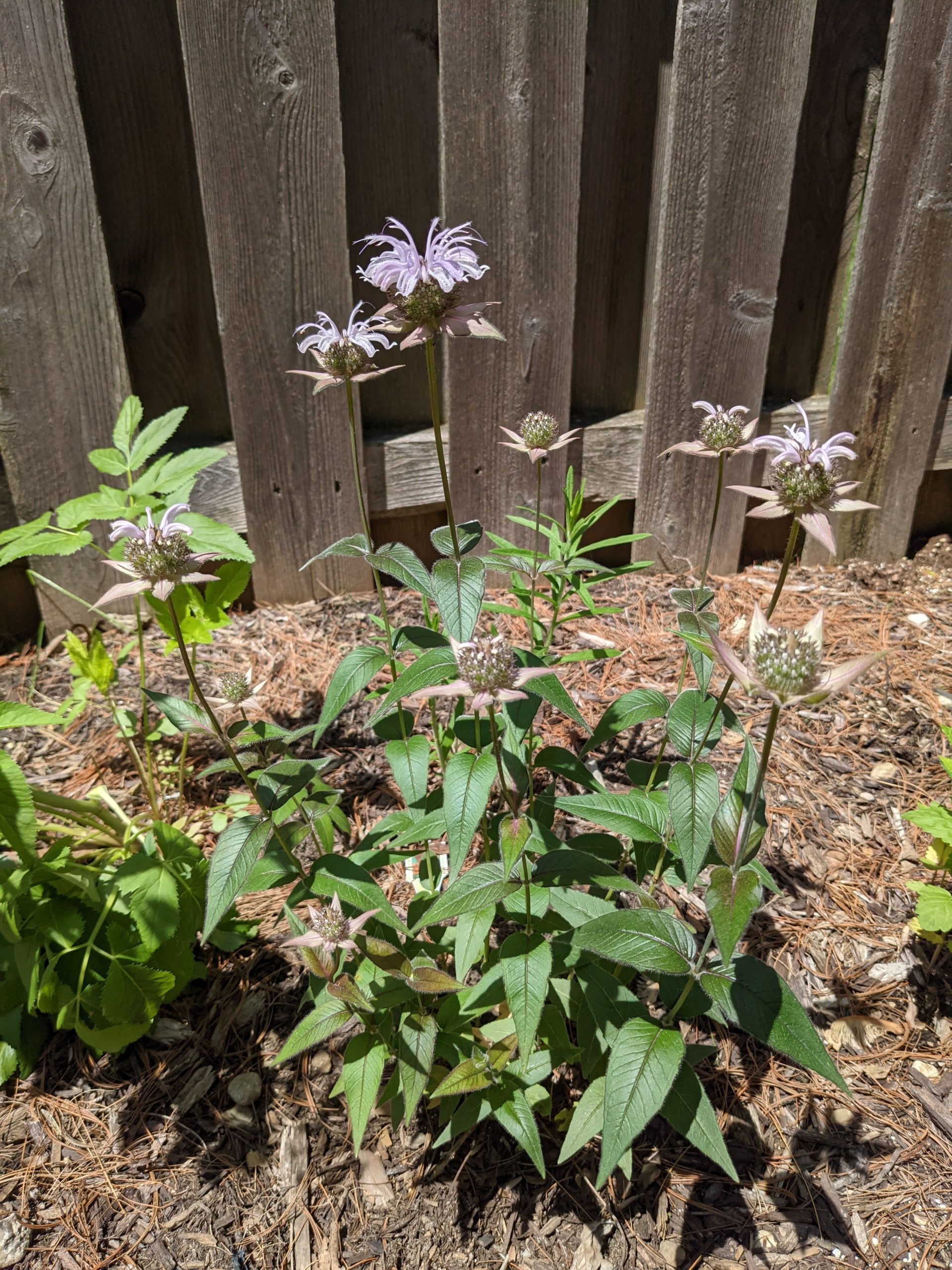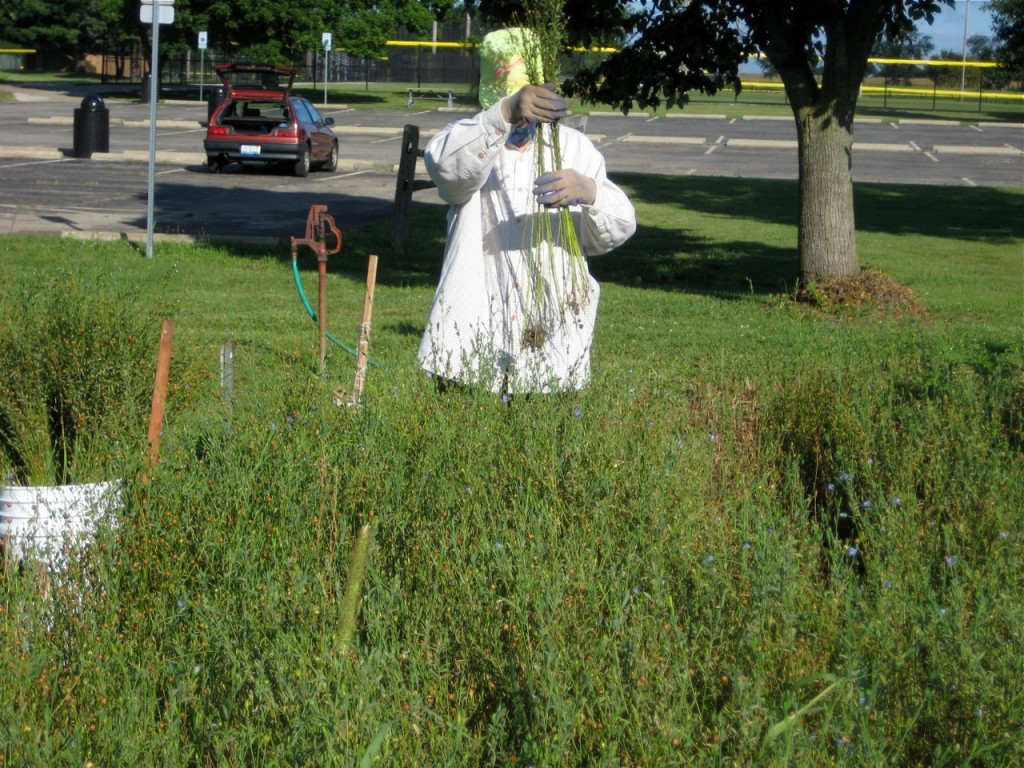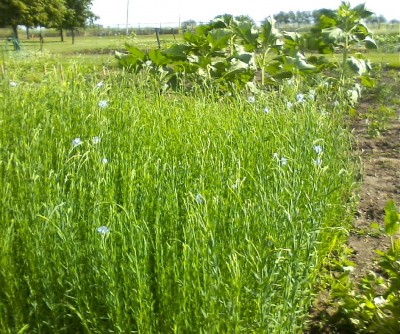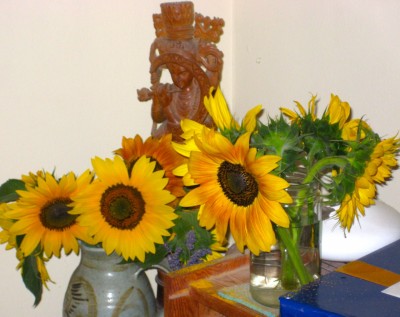
🎶 Mo-nar-da, whoa-o! Mo-nar-da, whoa-o-o-o! 🎶 Bradbury’s monarda in @jackieLbrewer’s pollinator hotspot.


🎶 Mo-nar-da, whoa-o! Mo-nar-da, whoa-o-o-o! 🎶 Bradbury’s monarda in @jackieLbrewer’s pollinator hotspot.

I’ve fallen rather far behind on my posts about growing flax this year, so this is something of a catch-up post. It covers the work we’ve done since harvesting—and not only brings us up to date, but pretty much finishes up the series. Jackie will, of course, spin our flax fiber into yarn, but she spins all the time, so that’s just normal around here.
So, in quick succession, here are the next steps after harvesting:
It’s a little odd that you’re supposed to dry the flax, giving that the next step is to soak it in water, and yet that’s how it’s done, and who are we to go against tradition?
Here’s one of our little flax stacks. This is well along in drying, although you can see that some of the interior stems are still pretty green.
Once the plants are dry, you want to remove the seeds. There’s a tool that’s basically a bed of nails spaced appropriately for catching the seed pods.
I neglected to get a good picture of our ripple, but here’s one cropped out of a larger picture:
You just draw each bundle of plants through the ripple a few times, and collect the seed pods that pop off.
We got a big coffee container full of seed pods. Unfortunately, a lot of the seed pods only have two or three seeds in them, making it pretty tiresome work to get flax seeds. If you spend about fifteen minutes at it, crushing each pod and then getting the seeds out, you can get maybe a quarter-teaspoon of seeds.
I blame colony collapse disorder. (Flax is bee-pollinated. The native bees do the best they can, but evidently without complete success.)
Once the flax is dry, you rett it—you subject it to a controlled rotting process, the purpose of which is to do some damage to the stem so that you can get to the fibers.
We retted our flax in a kiddy pool that we bought cheap at a local discount store:
You need to weight the flax down so that it’s all under water. We used some vinyl shutters that we got cheap at the Habitat for Humanity ReStore, together with some cheap tiles as weights.
Here’s a closeup of the bundles under the weights:
Retting is generally considered a stinky process, although ours wasn’t too bad. We retted each harvest separately, and it took about five days each time.
After retting, you have to dry the flax bundles. I didn’t get any pictures of this phase, but it’s not really different from the first phase of drying, except that now the bundles are rather limp, so that you need something for them to lean against if they’re going to stand up. The bundles have gotten lighter, though, so it doesn’t need to be anything very sturdy. We used the flower stalks of our bolted lettuce as supports.
Once the stems are dry, you need to break up the stem material that surrounds the fibers. This can be done with your bare hands (I did a couple of stems by hand, just to see the process in detail), but it would be pretty time-consuming and tedious. There’s a special tool for automating the process called a flax break. It’s kind of like a big paper-cutter, only with multiple blunt wooden blades
It turns out, there actually is a flax break not too far away, owned by Five Mile House, a historic homestead just south of Charleston, Illinois. They offered to let us use their flax break if we’d demonstrate how it was used.
So, on one Sunday in September, Jackie and I went to Charleston and “demonstrated” how to break flax. (I put the word in quotes because we really had no idea how to use the flax break, so our demonstration consisted mostly of letting people watch as we tried to figure it out.)
We only got about half the flax broken during that three-hour period, so we went back yesterday and finished the job.
If you do a good job of breaking, most of the unwanted material falls right off. (That material is called “boon” and is supposed to be good for all sorts of things. Basically, it’s mulch.)
Inevitably, some bits will still be wrapped around your fibers. Those bits are removed through scutching, which is striking the fiber bundles with something sharp enough to scrap things off the fibers, but not sharp enough to cut them. A real scutching knife looks rather like a wooden sword. We didn’t have one, but made do with various other items, such as a spatulas.
The last step is to comb the fibers to make them ready to spin. This step is called hackling, and is done with a hackle, which is basically a bed of nails like a multi-row ripple.
You just grab the scutched bundle in the middle and draw it through the hackle. Any short or tangled fibers will get caught in the hackle, and after a few passes, the bundle in hand will be a tidy bundle of long, straight, neatly aligned fibers. The long fibers are called “line” flax, and are considered the good stuff. The short fibers are called “tow” and are perfectly good fibers, useful for many things, but not fine linens.
In our second visit to Five Mile House we finished breaking our flax. We also got a good bit scutched and hackled. What had been enough flax bundles to completely fill the back of our hatchback is now just three paper grocery bags full of fiber.
That’ll be enough to keep Jackie spinning through the winter.
It’s been a very interesting process, and a lot of fun, but I doubt if we’ll do it again.
My plan for next year, as crop to occupy a big chunk of the garden so we don’t have to keep weeding it, is barley. (First year, malt syrup. If that works, second year, maybe beer.)

It’s hard to decide when to harvest flax. If you harvest early enough to get the finest fiber, you get no seeds. If you harvest late enough to get seeds to plant next year, you get coarse fibers.
The books suggest various compromises. One suggested 30 days after the peak of flowering, if you mostly care about fiber, and two weeks later if you mostly care about seeds.
We decided to harvest half of our plants today. We think it’s early enough to get good fiber. Indeed, some of the plants are still in flower. But there are plenty of seed pods that look like they’ll be full of seeds.
Depending on how things go, we’ll harvest the other half in a week or two. That may get us some more or better seeds. At least as important to me, it adds a bit of redundancy—if something goes wrong with the processing of this batch, we’ll have another batch that won’t suffer the same fate.
Jackie has suggested that we not try to save seeds to plant, but rather eat the seeds we get. (I assume she means to grind them up to use as flax-seed meal, which we do buy at the store and put in bread and such. Even if every seed pod turns out to be full to bursting with seeds, we’re only going to get a few tablespoons of flax-seed meal, but that’d be enough for several loaves.)
The first step to turn flax into linen, after growing the plants and harvesting them, is to dry them. The books suggest that you tie the stalks into bundles, then arrange the bundles into loose stacks for drying.
That’s where we are now:

 Jackie and I visited our garden today, where we’re growing flax with an eye toward making linen. We were pleased to find the first flowers on our flax plants.
Jackie and I visited our garden today, where we’re growing flax with an eye toward making linen. We were pleased to find the first flowers on our flax plants.
Sorry for the crappy photo—I neglected to bring my camera, so this was taken with my phone. Worse, it was windy, so everything was moving. Still, it gives you a general idea of how our flax is coming along—close to knee-high, and very thick and lush. (Apparently growing very thick is preferred if you’re growing flax for fiber, rather than for seed. Thickly packed plants grow straight and tall without branching, so you get the longest fibers. More sparsely grown plants tend to branch out, which is fine if you’re growing the plants for flax seeds, but not ideal if you want textile fiber.)
Somewhat more successfully, I took this photo of some bison with calves, in a field behind the hotel where we stayed in Greenville for our Sharp family reunion.

We went to the garden early, to harvest and water. (Right now, anything you want to do has to be done early, because of the heat.)
We took a lot of sunflowers—and these are on top of the flowers we got two days ago, and the ones from a couple days before that. We’d given away a bouquet to a woman with a garden plot near ours, and two bouquets to Jackie’s mom (one for a neighbor of hers), but we still had so many flowers that Jackie had to be quite inventive to find enough containers to use as vases, and enough places to put the vases.
So, I thought I’d take a picture of each bouquet, and then take a spin at using the blog’s ability to display galleries of images, and show off the many sunflowers currently decorating every room in our apartment. They’re not the best photographs ever, but with such a pretty subject as sunflowers, it’s possible to get nice pictures anyway. Click an image to embiggenize it.

 We’ve grown two kinds of sunflowers in our garden. One kind makes one enormous head for seeds. The other kind—this kind—is for cut flowers.
We’ve grown two kinds of sunflowers in our garden. One kind makes one enormous head for seeds. The other kind—this kind—is for cut flowers.
We discovered the first year we grew them that it’s critical to cut off the initial flower at the top of the main stem. Otherwise it just makes that flower as large as it can—not unlike the other kind of sunflower. But if you take that flower, the plants start making numerous medium-sized flowers on side stems. If you have four or six sunflower plants, you can expect to be able to harvest a few flowers every day for most of the summer.
After Jackie broke her wrist last summer, we had to abandon our garden, and our sunflowers didn’t get harvested. Instead, they bloomed, made seeds, and dropped them in the garden. The result is that this year we have lots of volunteer sunflower plants. Lots. I haven’t counted, but it’s more than four or six.
I don’t seem to have any sunflowers in the study yet, but I think every other room in the house has a vase of flowers, and I’m sure the study isn’t far behind.
Tomorrow we’ll have more flowers. And more the day after that.
I like sunflowers.

After Jackie broke her wrist, we quit going to the garden. She couldn’t do that sort of work at all, and I was so busy trying to do the bare minimum of my work plus the necessary fraction of the work she couldn’t do any more, anything extra had to be dropped. The garden was one thing we dropped.
Jackie’s nearly all better now. The splint has been off for several weeks. The hand therapist said she was doing well enough on her own and didn’t need formal physical therapy. (He gave her a bunch of exercises to do.) But we still didn’t go to the garden. It just seemed like it would be too depressing to see the remnants and imagine what our garden might have been.
And yet, we figured there’d probably be some stuff to harvest. We’d had a hot, dry summer, so we didn’t expect the tomatoes to have survived. And without us there to do the weeding, we figured the greens would have been overshadowed terribly by weeds. But the sage should have survived, and perhaps the peppers as well.
As it turns out, it wasn’t even quite that bad. Two of our cherry tomato plants did very well. And, as you see, the peppers produced in great profusion. We also got some sage, some swiss chard, and a some sunflowers.
Now I’m feeling a little silly that we didn’t get to the garden earlier. We’d certainly have gotten a lot more sunflowers—we could have had flowers steadily for all these weeks. We’d also have been able to eat the peppers steadily as they ripened, instead of getting a whole bunch at once that we’re going to have to preserve. But not very silly. We did about the best we could under the circumstances. To have gotten this much of a harvest despite doing no work since early July is kind of a bonus.